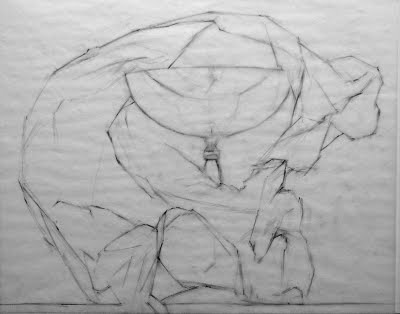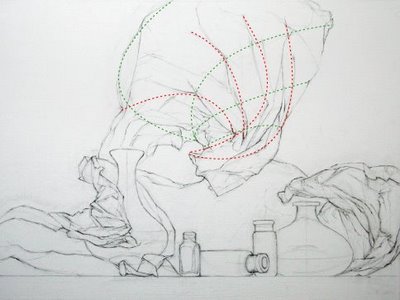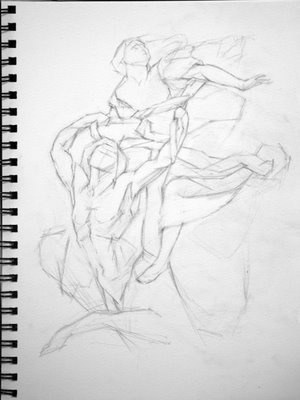My art studio, 2004
This was one half of my small kitchen in the 1-bedroom apartment I lived in. I did not have stable north light, so I hung a sheer white curtain to filter the direct sunlight.
In 2004 I took a class that taught me the basic historic technique for creating a layered oil painting. To practice I set up this little studio in my kitchen and a did a painting using the method I was learning in the class.
Study for Vase and Creamer
9 x 9 inches, pencil on paper
2004
The still life was the first drawing and the first oil painting I had done on my own in about 10 years. I was exhilarated and thrilled, and mostly just so relieved when I made this little painting.
Vase and Creamer
9 x 9 inches, oil on panel
2004
It had taken me years of "thawing out" a severe, crippling artists' block to get to the point where I could even attempt to make a painting.
...
For many years after I graduated from art school at RISD I was very discouraged as an artist. I did not ever make any art on my own, outside the occasional life-drawing class. I felt like I was an artist. But a real artist paints, and I was not painting. I felt like I "should" be painting.
I think I was stymied by my idea of what art and painting should be, by my idea of what was "Important Art."
Important Art was what was showing in the New York gallery scene of the 1990's, or in the New York MOMA. Important Art was what my art school friends who went on to do Masters of Fine Arts degrees were doing: very large, abstract or semi-abstract paintings.
I had never had an inclination to paint abstractly, and the semi-abstract figure-ish work I was introduced to in art school looked to me like what an insane person might paint.
All that was interesting to me intellectually, and I liked to look at it and talk about it with my friends, and I admired many of them for their skill with painting abstractly, but I never felt a shred of desire to paint that way.
But the only other option for a painter, other than Abstract or Figurative (semi-abstract figure-ish), was to be a Bad Artist. A bad artist was a "sellout" who sold pictures of flowers or children or seascapes at tourist galleries. I was very afraid that if I made that kind of art I would be a Bad Artist.
I left art school believing that Important Art came entirely or mostly from your head, and that art done while looking at something in real life was just a "study". Landscape, Figure, Portrait, and Still Life were all ok to do as studies, but if you were to do that for your real Work, you would fall into the category of Bad Artist.
I had been accepted into the most prestigious art school in the country based on my high school portfolio of highly realistic drawings and paintings done from life. And then I was taught that that was not art.
So, feeling like I was never going to be a Real Artist much less an Important Artist, I just stopped making art. I described myself to acquaintances as a designer, never as an artist.
For years I let people people assume I'd majored in design at the Rhode Island School of Design, and did not reveal that I'd spent all of my 4 years there doing figure drawing and oil painting.
But over the years after art school I got very depressed. I put in hours at my graphic design job, and mostly just killed time between my working and sleeping hours.
But I always knew what my problem was, I always knew that I would feel better if I could start painting. So I tried very hard for a lot of years to start painting. In fact, in my head, I was trying very hard to get back to painting pretty much all of the time.These were the things I tried:
- Trying to be "disciplined"
- Trying to be "motivated"
- Making plans to do x just 10 minutes a day
- Being angry and disappointed at myself
- Putting enormous pressure on myself
I did a LOT of that, all the time, for many years, and none of it was successful for helping me get back to making art. It just made me feel worse.
I began to realize that my idea that I might be a Bad Artist was stopping me from doing ANYTHING creative. So I decided to do the smallest, tiniest project that felt creative but that was NOT ART. As soon as I called it art, I could not make myself do it.
So the smallest, easiest thing I could find to do, that was a tiny bit creative, was going to a fabric store and buying buttons. I spent a long time picking out the buttons. I did not make anything with them, I just bought them.
It sounds so silly, and it's completely embarrassing to me that that was my creative project. It was embarrassing to me even then, when I did it. But I had gotten to such a low point of despair, that doing something so small and insignificant as buying buttons felt better than the way I felt most the time.
After I bought the buttons, and did some more equally small "creative projects", and after a while I felt inspired to play with collage. I had experimented with collage in art school, and so I started collecting materials again and making collages again. I did this on my living room floor, with the TV on. I made about 20 of these:
"The Stage", 2003
9 x 12, mixed media on paper
Then, in 2003 I saw the movie "The Girl with the Pearl Earring", which is about Vermeer. The movie imagines that the subject of his famous painting is his young maid, whom he trains to mix his paints. The movie is beautifully shot, with gorgeous sequences showing Scarlet Johansson sifting pigments and mixing oils by soft Dutch light filtered through small windowpanes.
I started wondering if anyone taught how to do Old Masters' painting techniques any more, and if I could learn any of that. A few months later I found
Kirstine Reiner's ad for art classes on Craigslist, offering lessons on mixing paint pigments and Old Master oil techniques. In early 2004 I signed up for 10 lessons.... and for the first time in many years, I picked up a paintbrush.
...
So many of my students struggle with how to set up a consistent practice outside of class hours. I can see the pressure they are putting on themselves, and their frustration.
I tell them to remember learning to drive a car as a teenager: There is no way you could learn to drive if you only practiced an hour or two a week in Driver's Ed for a couple months. You had to put in dozens, maybe hundreds of hours behind the wheel for a few years before driving a car started to feel completely comfortable and natural. Learning to paint is exactly like that. As the instructor, I can give you some help and ideas and guidelines, but to get a feel for painting, you just have to do it on your own for a few hundred hours.
But I know it's hard to find a way to put in those hours.
If you want to paint and you are not painting, then whatever you are currently doing to try to paint is not working, so try something completely different.
Instead, just do the smallest thing you can call "creative." Go for a walk and take some snapshots. But if you plan to do that and you find the weekend goes by and you didn't get around to it, do something smaller: just go browse in a flower shop or bicycle shop. And if that does not happen, just notice a crack in the pavement with some moss growing in it. Just stop and look at something that interests you for 5 seconds.
That's it, you are being creative.
We are all creative all the time, we just don't realize it. If you want to paint, you probably already notice things around you all the time you wish you could paint or draw. Our ideas about what is Art, or what is Real Art, or what is Good Art versus Bad Art , don't help us to actually be artists. Don't focus on being a good artist. Don't try to be motivated or disciplined, don't even try to be an Artist.
Just focus your attention on what interests you in your normal, day-to-day life, starting with just a few seconds or minutes at a time. The rest takes care of itself.
 Friday, December 10, 2010 at 12:46PM
Friday, December 10, 2010 at 12:46PM 

















